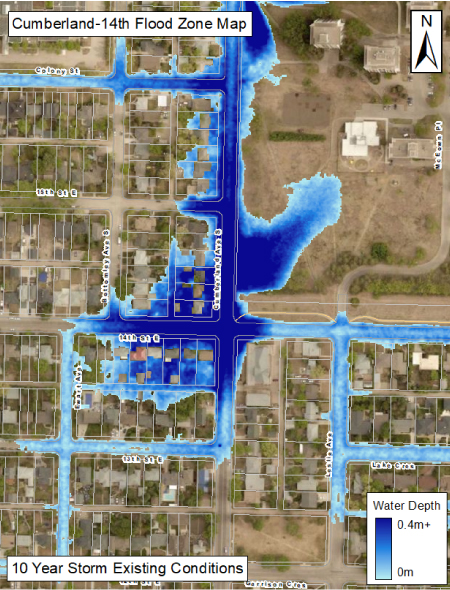USask Dry Storm Pond Project
A dry storm pond and other infrastructure improvements will be constructed on University of Saskatchewan (USask) land, to reduce the flood risk at properties near the Cumberland Avenue South and 14th Street East intersection. This is an area with a history of significant flooding and expected future flooding with climate change. Flooding has occurred during major storm events at this intersection since at least the 1960s.
The image below indicates the location of the proposed dry pond on USask land, which will be constructed adjacent to the existing wet pond east of the McEown Park residence buildings.

Why is there such a high risk of flooding in this area?
Flooding only occurs during significant rain events. Neighbourhoods developed prior to 1989 were not constructed to the same design standards and storage requirements in place today. Significant rain events are now managed through wet and dry ponds, which have the ability to collect high volumes of storm water.
What is a dry pond?
A dry storm water pond, or dry pond, is a storage area that temporarily holds rain water during intense rain events. The water is stored in the pond temporarily before it drains back into the underground pipe system. It is different from a wet pond in that most of the time the dry pond will not hold any water and can be used as park space.
How will this project impact the risk of flooding in the area?
The dry storm pond will provide approximately 17,000 m3 of storm water storage, reducing flooding at up to 19 properties during a 1 in 10-year rainstorm around the intersection of Cumberland Avenue South and 14th Street East. Instead of storm water ponding on the street and possibly entering nearby basements, the storm water will be transported to the dry pond to mitigate flooding for the area.
The map below displays flood risk in the area under current conditions in the event of a 1 in 10-year storm, followed by a map displaying the flood risk during a 1 in 10-year storm once the dry pond and additional storm water infrastructure is in place.
 |
 |
How will the nearby area be impacted?
Along with construction of a dry storm pond on USask land, new storm water sewer infrastructure will be installed connecting the existing storm sewer along 14th Street East to the southwest end of the proposed dry pond location. Additionally, new catch basins will be installed in the Cumberland Avenue South and 14th Street East intersection.
When will construction occur?
-
Dry pond excavation: February 2025
-
Installation of new storm sewer infrastructure and landscaping: May to October 2025
-
Landscape establishment: October 2025 to Fall 2026
-
Ongoing landscape maintenance: Fall 2026 to Fall 2028
What areas will be impacted by construction?
Below is a map displaying the construction areas.

Will trees be impacted by the project?
No. City-owned trees are planned to be removed during this project and removal of trees located on USask’s land will be minimized to the extent possible. New trees are planned to be planted on USask’s land as part of the project. If tree removal is required, appropriate stakeholders will be informed, and the project will provide necessary compensation as outlined in City Council Policy C09-011 Trees on City Property.
What is the Flood Control Strategy?
If you've ever experienced flood damage, you know how devastating it can be. Though parts of Saskatoon have always been susceptible to flooding, and flood protection measures to date have helped, climate change is expected to bring more frequent and intense storms.
In December 2018, City Council approved implementation of the nine-year $54 million Flood Control Strategy to mitigate flooding in ten areas that experience frequent flooding. The City of Saskatoon – USask Dry Pond Project is the sixth project receiving upgrades as part of this Strategy.
Visit the Flood Control Strategy page for more information.
How is the project being funded?
In 2019, the Government of Canada (Government) approved 40% cost sharing of the Flood Control Strategy's total estimated eligible expenses of $54.1 million, up to a maximum of $21.6 million through the Disaster Mitigation and Adaptation Fund. The City approved Storm Water Utility funding of $32.4 million through previously approved increases to the Storm Water Management Charge to cover the other 60% of the expenses.
The City – Usask Dry Pond project is estimated to cost $6.0 million, with the City contributing 60% ($3.6 million) and the Government of Canada through the Disaster Mitigation and Adaptation Fund is contributing 40% ($2.4 million).
